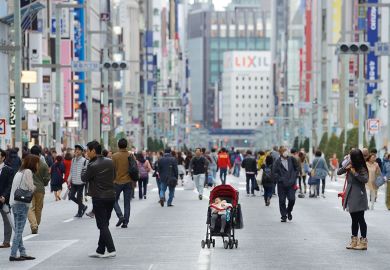“Big, flashy buildings” are not vanity projects but essential investments in 21st-century pedagogy that pay their own way, an online conference has heard.
Monash University vice-chancellor Margaret Gardner told Times Higher Education’s THE Live ANZ event that her institution’s original infrastructure had passed its use-by date. “The flashy new buildings we’ve built in recent years are all about…embedding new forms of technology that allow us to teach not just on campus but off campus and across countries,” she told the forum.
“We can’t do that in the existing buildings. We could not get more efficiencies. We could not be more effective. We could not employ new pedagogies.”
Australian university administrators have been pilloried for lavishing the proceeds of their lucrative overseas enrolments on expensive new buildings. Now, with Covid-19 punching holes in the country’s A$40 billion (£22 billion) international education industry, critics say university executives have squandered a short-lived revenue boom on gleaming white elephants.
A forum panel discussing the sector’s financial state was peppered with questions about construction spending. “Has Australia overinvested in flashy buildings on campus?” one delegate asked. “Many courses are online,” others noted. “Are all of those buildings needed?”
Professor Gardner said “a big, flashy biomedical teaching building” that opened at Monash last year had replaced anatomy labs dating from 1961. “In the new labs, we can teach surgeons and give them professional education, which we couldn’t have done in the quality of lab [where] we were teaching undergraduates,” she said.
“We were able to transform the…teaching of anatomy, bringing all-new technology in [and] expanding the number of students we could teach at once.”
Fellow panellist Stephen Parker, a former vice-chancellor of the University of Canberra, said he was yet to see any university “fundamentally rethinking the business and operating model” to the extent demanded by the pandemic-induced revenue crisis.
“If you look at some sectors, there’s been real transformation,” said Professor Parker, now global lead for education and skills with consultants KPMG Australia. “There is a reasonable amount of speculation in the university world, but nothing you can hold up [as] an example of a transformed university.
“By using technology, trying to get scale, I think you can change the equation. But I’m not seeing anyone there or possibly even close to there at the moment.”
He said universities needed to start designing online courses on the assumption that most learners would be off campus. Institutions had to make more use of emerging technologies in areas such as mixed reality and explore the full potential of learning analytics, he said.
“The first university that can enrol several hundred thousand students and give them a sense of a personalised experience that fits their abilities and career aspirations – that’s transformative.”
Machine learning also has transformative potential, he added. “In administration, not only robotic process automation but smarter forms of automation become possible. We might be able to glimpse a largely administrator-free university in the future.”
Professor Gardner said she would like to “get rid of a lot of boring transactions” that characterised university administration. “Unfortunately, to do something really new and cutting edge, you have to be able to invest lots of money,” she said.
“One of the reasons that transactions…often still [involve] pushing bits of paper around is that we haven’t had the money to put in the new technology that would get rid of that manual work.”




